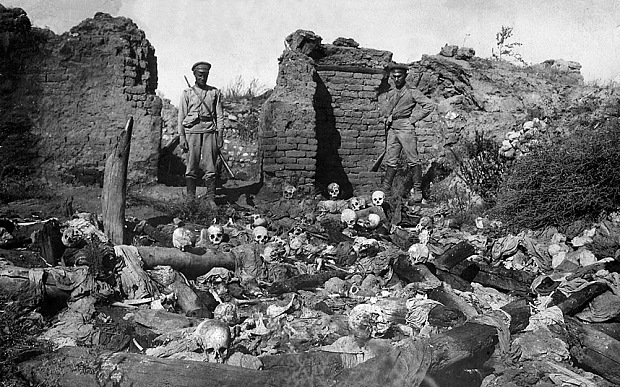by Hugh Fitzgerald

Lindsey Graham was criticized last week for blocking a Congressional resolution recognizing the Armenian genocide, and deservedly so. Despite the well-financed efforts of successive Turkish governments to convince the world that there never was an Armenian genocide, but only some clashes between the Ottomans and Armenians who “treacherously” took the side of Russia during the First World War, we all know, or think we know, the duration and scope of the Armenian massacres. In this generally accepted version, there were two distinct episodes of mass killings: first, from 1894 to 1896, the “Hamidian massacres” of Armenians instigated by the last sultan, Abdul Hamid II, and then, from 1915 to 1917, a second, much larger wave of massacres of Armenian men, women, and children by Turks. A recent book by Israeli historians Benny Morris and Dror Ze’evi, The Thirty-Year Genocide, makes the striking claim that the genocide by the Turks was continuously committed over a thirty-year period, from 1894 to 1924, against not only the Armenians, but also including the other Ottoman Christian communities of Greeks and Assyrians.
In an interview with Israeli newspaper Haaretz about the book, Morris said that between 1.5 million and 2.5 million Christians were killed during this period, basing this figure on the work of Turkish, Armenian and Greek statisticians.
“Our conclusion that between 1.5 and 2.5 million Christians were murdered, from 1894 to 1924, is a cautious estimate,” Morris said.
“(The) killing of two million Christians was effected through the calculated exhortation of the Turks to create a pure Muslim nation,” the book’s blurb on the website of its publisher, Harvard University Press, reads.
Morris says the founder of the Republic of Turkey, Mustafa Kemal Atatürk, was responsible for “the liquidation of the last Armenians who remained in Turkey,” as well as of hundreds of thousands of Greek and Assyrian Christians.
“Although Ataturk is considered to have been anti-Islamic, he mobilized Islam to execute that scheme, and he is the one who did away with the remnants of the Christian communities in Turkey. Nonetheless, the charge of ethnic cleansing never stuck to him,” Morris said….
This study will come as a salutary shock to many in the West, who until now have been unaware of the full dimensions of the genocide perpetrated by the Muslim Turks. It makes four main points. First, this genocide was not the result of two sudden upsurges — episodes — of communal violence, the first in 1894-96 and the second in 1915-1917, but took place, rather, over 30 years, part of a campaign to rid the Ottoman Empire, and then its successor the Turkish Republic, of its Christians. Second, the victims of the genocide were not only Armenians, but Greeks and Assyrians as well, whose mere existence as Christians offended so many Muslim Turks. By constantly referring to the Armenian genocide, we in the West inadvertently scant the other Christian victims. Third, the Israeli researchers offer as a “cautious estimate” a figure of between 1.5 and 2.5 million victims; until now the highest estimate for the number of victims has been 1.5 million. Morris and Ze’evi believe not only that there were “at least” rather than “at most” 1.5 million Christians murdered, but they are careful to add that even a figure of 2.5 million victims is likely to be an underestimate.
Fourth, the role played by Ataturk in this long-running genocide against Christians will surely come as a shock to many in the West. For as a secularist, famous for expressing his contempt of Islam, the enlightened despot who pushed many reforms that limited the power of Islam in the Turkish Republic, one might have expected him to oppose these Islam-prompted massacres of Christians. But he did not. He appealed to the very Islam he so despised to encourage Turks after World War I to continue the genocide that began in 1894, by killing not only the Armenians who still remained in what was now the Turkish Republic, but hundreds of thousands of Greeks and Assyrians as well. He used the desire of Turks for a “pure Muslim nation” to encourage continued killings (and expulsions) of Christians, even as he worked, in other respects, to dilute the power of Islam in Turkey. Our understanding of Ataturk will now have to be revised.
But what need not be revised is our judgement of Turkey itself. The Turkish government under Erdogan, like all Turkish governments since the Turkish Republic began, continues to flatly deny any systematic killing — “genocide” — of Armenians, and has not even bothered to mention the other victims — Greeks, Assyrians — of Turkish Muslim mass murderers. It will be fascinating to see how the Turkish government, and the well-financed Turkish lobby, handles this study, and the evidence it carefully adduces. So far the book has been greeted in Turkey with silence, and this will likely continue. If it is mentioned at all, it will be dismissed, rather than seriously discussed, as the work of “two Zionists” eager to blacken the name of Turkey and of Islam. And many Turks, with Erdogan leading them, will be all too ready to believe such a preposterous accusation.
First published in Jihad Watch.
- Like
- Digg
- Del
- Tumblr
- VKontakte
- Buffer
- Love This
- Odnoklassniki
- Meneame
- Blogger
- Amazon
- Yahoo Mail
- Gmail
- AOL
- Newsvine
- HackerNews
- Evernote
- MySpace
- Mail.ru
- Viadeo
- Line
- Comments
- Yummly
- SMS
- Viber
- Telegram
- Subscribe
- Skype
- Facebook Messenger
- Kakao
- LiveJournal
- Yammer
- Edgar
- Fintel
- Mix
- Instapaper
- Copy Link









